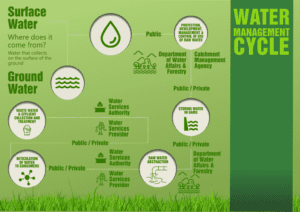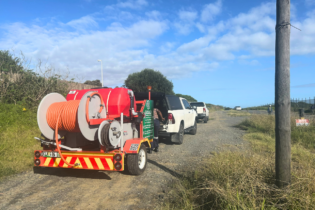By Russell Dick*
Water. In the last year, you’ve heard endless sound bites, read numerous articles, and had countless conversations with Capetonians and other affected stakeholders. So it’s likely that you already know this: there will never be any more fresh water on earth than there is right now. No new water is being made and the water we use is recycled, over and over again. But do you know the key players in the water provision process, what each does, and how the water actually gets from the dam to the tap? In this article, I examine how the different water sector institutions link to South Africa’s water and sanitation business cycle, and their roles and responsibilities.What to expect
Regulation 3 of our country’s Compulsory National Standards and Measures to Conserve Water (June 2001) states that the minimum standard for basic water supply services is:- The provision of appropriate education in respect of effective water use; and
- A minimum quantity of potable water of 25 litres per person per day or 6 kilolitres per household per month, at a minimum flow rate of not less than 10 litres per minute; within 200 metres of a household; and with effectiveness such that no consumer is without a supply for more than seven full days in any year.
Two key role players
In SA, water services authorities and water services providers collectively handle our ‘water services’; namely, water supply and sanitation. The former is a municipality, and has executive authority for water services within its area. It may carry out the functions of a water services provider or enter into a contract or service delivery agreement with one, where the latter then provides water supply and sanitation services to consumers. In simple terms, the municipality has the constitutional obligation to ensure service delivery but not necessarily to provide it. Importantly, it is the duty of the water services authority to ensure efficient, affordable, economical and sustainable access to water services. But Government has pointed out that this is subject to:- the availability of resources
- the need for an equitable allocation of resources
- the need to regulate access to water services in an equitable way
- the duty of consumers to pay reasonable charges
- the duty to conserve water resources
- the nature, topography, zoning and situation of the land in question
Water services providers are responsible for physically providing water and sanitation services to consumers, under contract to the water services authorities. They may be public or private bodies: water boards, NGOs, community-based organisations or private sector companies.
Two water sources
Whoever provides the water, however, it comes from one of only two possible sources: surface water or ground water. Ground water is located deep underground in veins of water known as aquifers. It can be accessed by drilling a borehole into the ground and then using a pump system to bring it to the surface. If you have a private borehole on your property or premises, you’re using ground water from an aquifer.The WWF says, “We have proven our ‘hydro-ingenuity’ ever since the first dam was built in 1663. SA has an impressive but ageing and failing network of engineered infrastructure that has stored and transferred water to where we need it. Most of the surface water that we can reliably use has been allocated, so future growth in storage and supply will need to come from underground.”Currently, only 15% of the country’s total water consumption is obtained from ground water sources. Surface water, on the other hand, is found on the surface of earth. Solar energy evaporates water from the ocean, lakes, rivers, and streams. Millions of litres rise into the atmosphere as an invisible gas, water vapour. As the water vapour is pushed over the land by winds and rises over mountains, it cools and turns back into tiny water droplets, forming clouds. The droplets joining together is termed condensation. These droplets fall to earth as rain or ‘precipitation’. The rain runs into streams and rivers, which eventually flow into lakes or the sea, and the water cycle begins again.
South Africa’s issue
But first: the bad news. SA receives an annual rainfall of 492mm, while the rest of the earth receives 985mm. This is only half of the earth’s average, and is the reason for SA’s classification as a water-stressed country.There is also an uneven distribution of rainfall across our country. The eastern half is much wetter than the western half, and hot, dry conditions mean more evaporation. Scientists also predict that, with global warming, SA will have wetter wet seasons and drier dry seasons; i.e. more floods and droughts.
The business cycle
A water utility accesses surface water by building an intake to draw water to a location for analysis, treatment, and pumping. There, it filters and treats water with chemicals to remove impurities and to make sure it is safe to use and drink; i.e. ‘potable’. Potable water is stored in a reservoir, from where it is then pumped through underground water mains into your home or office.In SA, different institutions manage various components of the water cycle, so the water and sanitation business cycle usually looks something like this:
- Protection, development, management, and control of use of raw water (surface and ground water)
- Maintaining the quality of surface and ground water so that it can be used in an ecologically sustainable way;
- Preventing degradation of the river or aquifer; and
- Rehabilitating the river or aquifer.
- Storing raw water in the dams
Once again, because the national government is the public trustee of the nation’s water resources, the Department of Water Affairs and Forestry is mandated to develop, operate and maintain the inter-basin transfer schemes and the storage dams used to store the raw water. But any institution (or person) can construct and operate a dam if it has the right license.
- Raw water abstraction, bulk water treatment (purification), and bulk potable water distribution
Bulk water services providers are responsible for developing, operating and maintaining abstraction works and bulk potable infrastructure (such as bulk water treatment plants and pump stations), and reservoirs and pipelines for distributing bulk potable water to the municipal reservoirs.The municipality can either fulfil this function itself, or contract a separate bulk water services provider (who may also be the water services provider responsible for the municipal reticulation infrastructure). In areas where a water board exists, it will usually fill the role of bulk water services provider. The primary function of a water board is to provide water services to other water services institutions, under contract.
- Reticulation of water to consumers
The water services authority, i.e. the municipality, is responsible for ensuring that water infrastructure is developed, operated and maintained. Municipal infrastructure comprises the municipal reservoirs, the pump stations, and the pipelines used to reticulate the water to the consumer.The municipality may also manage revenue collection and customer relations, and promote health and hygiene awareness. Alternatively, the municipality may contract with an external water services provider to carry out these functions on its behalf.
- Waste water and effluent collection and treatment, and returning the treated effluent back to the river
The bottom line
The bottom line here is one you’ve heard before: Cooperation is required.A water-secure future necessitates close cooperation between the public and private sectors, to address SA’s significant and accelerating water challenges.Matters of water governance, scarcity and pollution are becoming more pressing realities for agriculture, industry and other sectors, and functioning within these growing risks requires optimal water management practices. * Russell Dick is CEO of MICROmega H20.








